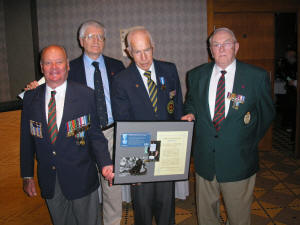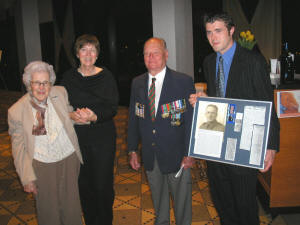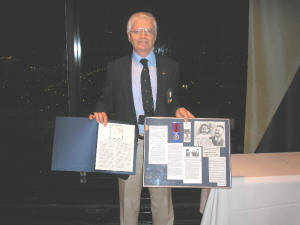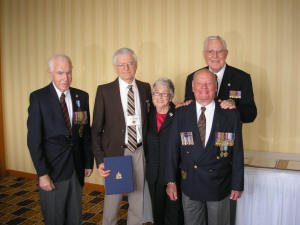(information submitted by Ron McGuire unless otherwise stated)
Ron McGuire at the exhibit table he prepared for the 2008 CVHofV Induction Lunch. Since 2005 he has been given space at this event to show photos and text concerning the "C" Force veterans being inducted and other background material. It is typical of the exhibit he prepares and shows at any opportunity to publicize our Veterans and some of their many stories
2005
Induction of Sgt. Maj. John Osborn
 Gerry Osborn, son of Sgt. Maj.
John Osborn, VC, Winnipeg Grenadier receiving the Induction
Portfolio from Ron McGuire. Photo courtesy of Sgt Maj Osborn's
grand-daughter, Dawn Stillwell
Gerry Osborn, son of Sgt. Maj.
John Osborn, VC, Winnipeg Grenadier receiving the Induction
Portfolio from Ron McGuire. Photo courtesy of Sgt Maj Osborn's
grand-daughter, Dawn Stillwell
Induction of Sgt Lance Ross
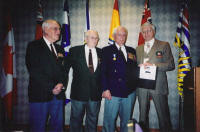 left to right -RR of C Sgt. Robert Barter, Phil
Doddridge, with Sgt, Lance Ross receiving his Induction Portfolio
from Ron McGuire. Sgt Ross was twice recommended for the Military
Medal for his actions during the Battle. After Ron read the
Induction Statement he prepared, Sgt. Ross was escorted to the
podium by his two comrades and they received the first standing
ovation given by those attending an Induction ceremony. Photo courtesy of Mitzi Ross.
left to right -RR of C Sgt. Robert Barter, Phil
Doddridge, with Sgt, Lance Ross receiving his Induction Portfolio
from Ron McGuire. Sgt Ross was twice recommended for the Military
Medal for his actions during the Battle. After Ron read the
Induction Statement he prepared, Sgt. Ross was escorted to the
podium by his two comrades and they received the first standing
ovation given by those attending an Induction ceremony. Photo courtesy of Mitzi Ross.
2006
Induction of "Sgt" Gander, Dicken Medal, RRofC
left to right-Sgt. Robert "Flash" Clayton, Ken Ewing and Phil Doddridge, all RRofC, holding the frame prepared by Ron McGuire [standing beyond the lads] concerning Gander
2007
Induction of Robert (Flash) Clayton and Jesse Clayton
left to right ---Ken Ewing [RRofC], Ron McGuire holding the Clayton's Induction portfolio, Jessica [Jessie] Clayton [CWAC], Robert [Flash] Clayton and George MacDonnel [RRofC]
2008
(information submitted by Ron McGuire)
Private Harold Atkinson and L/Cpl Ronald Atkinson MM
This text was prepared and read at the CVHofV Induction Luncheon on 24 May 2008 by C.R. [Ron] McGuire.
Private Harold Atkinson and L/Cpl Ronald Atkinson, MM
Like their father William, who fought in the First World War with the 108th Battalion, Private Harold Atkinson and his older brother Lance Corporal Ronald Atkinson, MM, joined the Winnipeg Grenadiers to serve their country. They were together in Jamaica when the Regiment was there as “Y” Force, guarding German Prisoners of War in 1940-41. When the Regiment was recalled to Canada, and made part of “C” Force, the Atkinsons went with it to Hong Kong. They were one of the many families, with more than one member, among the 1, 975 Canadians who fought in the Defence of Hong Kong. After the Japanese attack on 7 December, Harry and Ron were both in the thick of the heaviest fighting until it ended on Christmas Day. They became Prisoners of War, along with the other allied survivors who had courageously fought against a much larger, better trained, and experienced enemy.
Harry was forced to perform grueling slave labour building Kai Tak air field in Hong Kong. In 1943, he was one of 1,184 Canadians transferred to Japan in the second of four drafts, aboard what are known as “Hell Ships”. I had the privilege to know Harry and he shared with me, that he and his comrades thought they was going on to a place with better conditions. Unfortunately, even the -‘best’- of the camps in Japan had inhumane work and living conditions that were worse than POWs had endured in Hong Kong. When he left Canada, Harry weighed 170, when he was liberated; he had dropped to only 105 pounds. He did dangerous work on the Niigata dockyards, carrying crates and sacks as heavy as his malnourished body. On New Year’s Eve 1944, the roof on the poorly build hut in which he lived, collapsed from the weight of snow. Eight Canadian POWs were killed and many injured, including Harry, who suffered a broken pelvis and crushed ribs. His will to live helped him recover and kept him going until liberation when he returned to Winnipeg.
Harry’s strength and determination was his life long hallmark. After great effort he regained his health and went on to tirelessly fight another battle, with the Government of Canada, for the rights of Hong Kong Veterans. He was President of the Manitoba Branch of the Hong Kong Veterans Association and the Pension/Welfare Officer with its National Office. In these positions and, later as National President, Harry was an excellent representative and spokesman for his comrades. He helped secure significant improvements in their pensions and benefits. In recognition of his dedication, service, and self sacrifice Harry received the Queen’s Jubilee Medal in 2002, the year he passed away on 2 March.
During the Battle, Lance Corporal Ronald Atkinson and his section were assigned to defend the Wong Nei Chong Gap. This is where “D” Company of the Winnipeg Grenadiers encountered some of their fiercest fighting. For three days, less than 100 Grenadiers fought off several hundred Japanese troops. When it was over, Ron and only 36 other wounded Grenadiers were left. The Japanese thought the sector had been held by two battalions and were shocked to find that it was only one Company. As a consequence, the Japanese Commander was forced to make a public apology to his superiors.
For his brave actions during this engagement, Ron was awarded the Military Medal.
His Citation states:
“At dawn on 19 December when the Japanese attacked the Wong Nei Chong area, a section of the Winnipeg Grenadiers under command of Corporal Derek Everard Rix was cut off from its platoon. They worked their way from an open position on the hillside above the Blue Pool Valley to join a section of the Hong Kong Volunteer Defence Corps who were holding Pill Box No. 2 on the slopes of Jardine’s Lookout, and co-operated in its defence during the remainder of the morning: Lance-Corporal Atkinson was operating from a very exposed position.
When Lieutenant E.C. Field of the Corps, in command of the pill box was about to go forward to throw a grenade in some dead ground where he suspected the presence of Japanese, Lance-Corporal Atkinson, seeing Field was wounded, asked to do the job. He went forward, fully exposed to deliberate rifle fire and threw the grenade, but was wounded in the right arm before he could return to his position, and made his way to Pill Box No. 2 for first aid treatment.
Later when enemy presence increased and there was no sign of relief, Lieutenant Field gave leave to walking wounded to retire, but Atkinson preferred to stay and see the action through to the finish. Lance-Corporal Atkinson’s actions throughout, were those of a brave soldier whose devotion to duty assisted materially in prolonging the defence of this sector”.
Ron never recovered from his wounds; he died on 8 October 1943 in Hong Kong. Conditions in Japanese camps were the worst of all those operated by the enemy, with 25% casualty rates compared to less than 1% in German camps. Had the Japanese given Ron Atkinson proper medical treatment soon after being captured, he may have returned home with his brother and the other, Canadian Heroes of the Defence of Hong Kong.
For those wanting to know more about the many faceted and, sad history of Canada’s Hong Kong Veterans I highly recommend this 60 minute VCR tape, also available as a DVD---“Canada’s Hong Veterans-The Compensation Story”. It is part of the War Amps excellent “Never Again” series which cover many aspects of Canadians and Newfoundlanders at War. I am pleased to see that Cliff Chatterton, the patron of Canada’s Hong Kong Veterans and, long time driving force of the War Amps’, is with us today.
In 2001, the Hong Kong Veterans Association “Passed the Torch” to the Hong Kong Veterans Commemorative Association. Among the many things this group does to ensure that the sacrifices of the Atkinson Brothers and their comrades are Never Forgotten, is the construction of a Memorial Wall, planned for unveiling in Ottawa next year. There are descriptive brochures for this Memorial on the table near the entrance. Please take one.
Please welcome, Ron Atkinson’s son, Lynn and Harry’s daughter, Lori Smith Atkinson, who are here to accept their fathers’ Induction Portfolios.
left to right: Ruth and Lynn Atkinson, Ron McGuire, Lori Atkinson-Smith and Doug Smith, after the Induction of Ronald and Harold Atkinson, MM
Sgt George MacDonell
Induction Statement
George MacDonell commenced his long and distinguished service to Canada when he joined the Militia in Listowel, Ontario at age fifteen. I am proud to be his son and to have the honor of reading this Induction Statement.
On September 2, 1939 George joined the Canadian Army Service Corps. To his disappointment, his young age excluded him from going with them and the First Division to England. He was transferred to the Royal Canadian Regiment and, because of his experience, was promoted to Lance Corporal and became an apprentice instructor. By September 1940 he was a Sergeant with the Royal Rifles of Canada. When he left the Regiment in 1946 he was a Company Sergeant Major.
George served with ‘W’ Force while the Regiment was on garrison duty in Newfoundland until it became part of the 1,975 member ‘C’ Force which was sent to Hong Kong. After the Japanese attack on December 7 1941, he saw continuous harrowing action which tested his skills, leadership and bravery to the ultimate. Major Maurice Parker, his Commanding Officer, recommended he be awarded the Military Medal [MM]. But, as is often the case, the recommendation was changed, after being received by the authorities, to a Mentioned-in-Dispatches [MID]. The citation states:
“Sergeant MacDonell was Platoon Sergeant, No. 17
Platoon, “D” Company, Royal Rifles of Canada, during the defense of Hong
Kong in December 1941, and throughout the action he displayed a high
standard of courage.
On 25 December, owing to casualties, he was given command of No. 17
Platoon and ordered to attack an objective in Stanley Village. He led
the attack in the face of heavy enemy fire without supporting artillery
or machine gun fire, with conspicuous gallantry and showed outstanding
qualities of initiative, dash, coolness and leadership under very
difficult and hazardous conditions.
Sergeant MacDonell was at all times an example to men under his command
and his conduct was in line with the highest traditions of service.”
Along with his surviving comrades George became a prisoner of war and
for nearly four years and was forced to perform slave labor for the
Japanese under the most cruel and inhumane conditions. Through sheer
determination he endured his ordeal and was able to return home. After
regaining his health he completed his education while working at a
variety of jobs. From 1950 until 1982 George had a successful career as
a senior executive with Canadian General Electric, GSW, Maple Leaf
Mills, John Wood Manufacturing and the Council of Ontario Construction
Associations. Within months of retiring he was offered a six month
contract with the Government of Ontario. This led to a new career as
Deputy Minister of Industry, Trade and Technology, which continued until
retiring again in 1990.
George began another career when he decided to write about his life and war time experiences. In 2000 he published “This Soldier’s Story”. In 2002 he published a greatly expanded version renamed “One Soldier’s Story”. While the books tell his story they also tell the stories of his comrades, one of whom is here with us today – Eric Maloney. I believe the following quote vividly describes some of what haunts all survivors of Japanese POW camps ---
“During the years that followed, I never shook off the sad memories of the past, and very seldom have lived through a day entirely free of the tragedy of Hong Kong and the seemingly unnecessary deaths of so many of those young men. Again and again, I have lived through the horror of those four years in my dreams. These dreams persist even to this day and the theme is always the same. In my dreams, I learn that we prisoners in Japan will never be allowed to go free or see our families and Canada again. Even though the war is over, we will remain forever in Japan as slave laborers and as prisoners of the Japanese.”
He has given his books to schools, groups and the Hong Kong Veterans
Commemorative Association from whose web site store they may be
purchased. Whenever requested George also makes himself available to
give his illustrated presentation to schools and groups.
His presentations and books actually inspired a pilgrimage to Hong
Kong in 2005, the Year of the Veteran, by students, teachers, Hong Kong
veterans and their families. While George and five of his comrades
watched, the students buried the Remembrance Capsule they prepared at
Sai Wan Cemetery, where 283 Canadians are buried of which 107 are
unidentified. The other 274 Canadians who did not return are buried
elsewhere. The pilgrimage is well recorded in “Passing the Torch, Our
Youth Remembers Hong Kong”. George wrote the Forward to this excellent
booklet which also includes articles, poems and artwork done by students
for each of their ‘adopted’ Hong Kong Veteran. George also wrote about
his impressions of the pilgrimage and appropriately entitled the
booklet, “The Last Goodbye”.
Through his many efforts George MacDonell has helped to make the
story of Canada’s Hong Kong Veterans better known and to ensure that
they are Never Forgotten.
I am extremely pleased to tell you that George MacDonell is with us today. Dad, on a more personal note, I wrote a short poem I’d like to read to you:
Poem
In wartimes you taught your comrades how to fight,
That freedom was something they need to defend both day and night.
Against all odds you fought bravely to preserve our
liberty,
Surviving to coach the youth of today that protecting our way of life is
their duty.
As the head of our family you’re “the best” in our
minds,
The love and support you’ve given us is hard to define.
Dad, if I become half the man you are,
I’d be happy that I had come this far.
Ladies and Gentlemen, please help me welcome my hero and one of Canada’s Heroes of the Defense of Hong Kong, as he comes up to accept his Induction Portfolio.
from left to right: George MacDonell's cousin David Hay, his wife Beverly Hay, George, his son Paul, daughter-in-law Jessica, grandson Tyler MacDonell and daughter Susan Charlton
